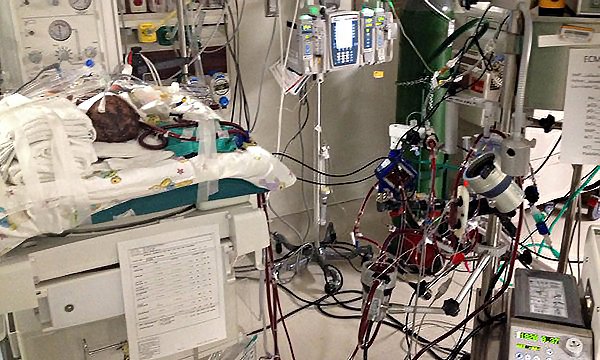What is ECMO and how can it save the sickest of children?

ECMO can support children with primary respiratory and cardiac failure

Extra corporeal membrane oxygenation (ECMO) is a technology capable of providing short-term mechanical support to the heart and/or lungs (Millar et al 2016).
In standard mechanical ventilation, the child’s heart continues to act as a pump and circulate blood, while the lungs continue to oxygenate the blood and remove carbon dioxide. In the event the child’s heart or lungs can no longer provide these functions, ECMO is considered.
How is ECMO used and what does it do?
ECMO itself is not a cure for the underlying cause of the child’s condition, it allows time for the heart and lungs to rest and heal following injury or disease, while waiting for a reversible condition to resolve through other treatment (Robinson and Peek 2015).
As ECMO replaces the function of the heart and lungs, it also reduces the damaging effects of aggressive mechanical ventilation and drugs used to sustain normal function in conventional therapy (Dixon and Crawford 2012).
ECMO is used to support children in acute illness but can also be used as a bridge to cardiac transplantation, allowing more time for decision-making and to prepare a child for transplant (Roeleveld and Mendonca 2019).
In acute illness, respiratory indications include status asthmaticus, pneumonia and congenital diaphragmatic hernia. Cardiac indications include cardiogenic shock and cardiac failure (Thompson et al 2018). The neonatal population accounts for nearly half of all child and adult patients placed on ECMO (Van Ommen et al 2018).
As extra corporeal suggests, the function of the heart and/or lungs occurs outside the child’s body. Blood is pumped through a membrane lung where blood is oxygenated and carbon dioxide and water vapour are removed (Roeleveld and Mendonca 2019). The child’s temperature can also be controlled by altering the temperature of the blood returning to them which is an important consideration for interventions such as therapeutic cooling (Thompson et al 2018).
In a healthy circulation, veins return deoxygenated blood to the right side of the heart, while arteries transport oxygenated blood away from the left side of the heart. This natural flow of blood dictates which of two circuits are used to support the child. Sinha et al (2017) explain that when the child is in primary respiratory failure but the heart continues to act as a pump, blood is removed and returned to the right side of the child’s heart, this is known as venovenous ECMO.
When the child also requires cardiac support, blood is taken from the right side of the heart and returned to the left side, in effect bypassing the heart. This is known as venoarterial ECMO and is used with any suggestion of cardiac failure, regardless of respiratory status.
When should ECMO not be used and are there associated risks?
ECMO is not appropriate for all children. Dixon and Crawford (2012) caution that chronic lung disease, severe neurological deficits, malignancy and irreversible underlying disease can exclude a child from ECMO.
ECMO itself adds many risks. Complications are vascular, with bleeding the most common complication because children on ECMO are anticoagulated to prevent clots forming in the ECMO circuit (Thompson et al 2018).
Roeleveld and Mendonca (2019) add that the longer the ECMO duration, more complications such as renal failure or infection may occur which can affect survival.
This article has been subject to open peer review and checked for plagiarism using automated software
References
- Dixon M, Crawford D (2012) Paediatric Intensive Care Nursing. John Wiley & Sons, Oxford
- Millar JE, Fanning JP, McDonald CI et al (2016) The inflammatory response to extracorporeal membrane oxygenation (ECMO): a review of the pathophysiology. Critical Care. 20, 387. doi: 10.1186/s13054-016-1570-4
- Robinson S, Peek G (2015) The role of ECMO in neonatal and paediatric patients. Paediatrics and Child Health
- Roeleveld PP, Mendonca M (2019) Neonatal cardiac ECMO in 2019 and beyond. Frontiers in Pediatrics. 7, 32, 1-13. doi: 10.3389/fped.2019.00327
- Sinha S, Miall L, Jardine L et al (2017) Essential Neonatal Medicine. John Wiley and Sons, Oxford
- Thompson AF, Luan J, Al Aklabi MM et al (2018) Pediatric extracorporeal membrane oxygenation (ECMO): a guide for radiologists. Pediatric Radiology. 48, 1488–1502. doi: 10.1007/s00247-018-4211-z
- Van Ommen CH, Neunert CE, Chitlur MB (2018) Neonatal ECMO. Frontiers in Medicine. 5, 289, 1-8

